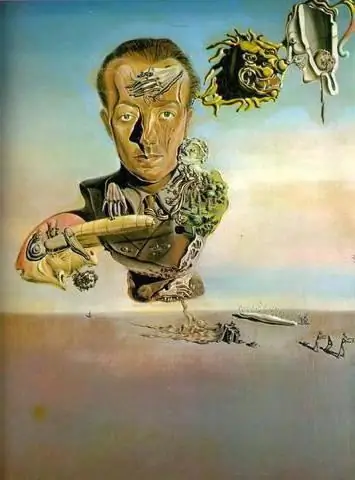2025 Author: Leah Sherlock | [email protected]. Last modified: 2025-01-24 17:46:31
The French painter, author of several art books and yachtsman was known as a versatile personality. Already during his lifetime, this man became a recognized classic and the main representative of neo-impressionism. For his services, he was awarded the Order of the Legion of Honor. And after his death at the age of 71, contemporaries said that the talented artist had three favorite and endless horizons - art, the sea and humanity.
Dream of painting
Progressive artist of the XIX century Signac Paul was born in Paris in 1863 in the family of a prosperous merchant. He recalled that his childhood was completely carefree and caressed by parental love.

After graduating from college, Paul tells his parents that he does not intend to go to university, but wants to fulfill the main dream of his life - to become a painter. Researchers of Signac's work are sure that such a desire is dictated by his father's hobby: at his leisure, he made sketches of landscapes, and the boy, as if spellbound, followed the birth of amateur paintings. And the neighborhood with Montmartre, in which the art workshops of French talents were located, left itsimprint.
Casus at the exhibition
Parents did not resist the desire of their only son to engage in creativity. Signac Paul is completely immersed in contemporary art, visiting all the art exhibitions and starting to copy the works of famous impressionists. There, an unusual incident happened to him, which the young man recalled without much pleasure.
At the Impressionist exhibition, Paul, taking paper and pencils with him, began to carefully redraw Degas' painting. Immediately, the exhibited debutant and little-known Gauguin approached him with a demand to stop copying. The young man had to retire in disgrace.
Monet lover
In 1880, his father dies, who left a good fortune to his son, not particularly concerned about finding work, but only busy with his work.
Thinking about studies that would develop his talent to the fullest, Signac did not even think about entering the School of Fine Arts, realizing that he was not on the way with the standard teaching of traditional painting. He idolized the work of Monet, admiring his rendering of the Seine River. According to the future genius, only impressionism can so accurately depict the elusive movements of water flows and the amazing play of sun glare on it.
Paul dreams of meeting his favorite artist to learn all the secrets of his work. He writes an enthusiastic letter to the venerable painter with a request to accept him. The meeting took place, but Signac was extremely dissatisfied with the cold reception of the master, who did not answer the questions of interest to the young man, sending himgaining experience from their works and noting that they are not engaged in mentoring.
Paintings painted in the sea
Paul Signac, whose biography is marked by creative ups and downs, already in 1882 wrote his first paintings, imitating his favorite author. He was always interested in the transmission of natural variability in the paintings of the Impressionists, who talentedly depict water ripples and reflections in the river. In order to draw from life, Signac acquires a small sailboat, on which he often travels and makes sketches. At that time, rowing became a very popular sport, and many artists pay tribute to it by buying swimming equipment for their work.

One of the significant works of the painter is the painting "Cross of Sailors". The seascape conveys the artist's sad thoughts about the tragic games of humanity with the natural elements and resembles Monet's canvases.
Pointillism and Neo-Impressionism
Paul Signac, whose paintings are painted using dotted strokes of pure unmixed colors, applied the pointillism method borrowed from his friend, the artist J. Seurat.

When considering his paintings from a certain angle, the human eye perceives the work as a whole. Before starting to paint in this manner, Paul studied theories about the laws of optical perception and color solutions for a long time.
Different from the Impressionists
This is the difference between Signac's paintings and the Impressionists, who overlaycolors on their canvases unconsciously, guided only by their intuition. The painter outlined the principles of a new direction in art in a book in which he called his style neo-impressionism. He kept a diary where he recorded all his observations of the play of color and light.
This technique made it possible to create real masterpieces of landscape painting, but was poorly suited for the portrait genre.
Canvases composed of strokes
"The Papal Palace in Avignon", written in 1890, perfectly demonstrates Signac's style of writing. The smallest strokes of paints not mixed with each other lie flat, visually creating a complete picture of the palace in France. To his left, the artist depicts a bridge created with colors of green shades. Nearby, the painter applies strokes of a different color without mixing them together.

And if near the picture looks like a canvas consisting of small spots, then at a distance the strokes merge, forming the integrity of the work. Signac, who studied the theory of optical effects, took into account the findings of the Impressionists in painting, remembering that when the lighting changes, the colors of the paintings change.
Inspired by the scenery of Saint-Tropez
Since 1892, the artist Paul Signac has been discovering the beauties of the Mediterranean nature of France. He leaves for the south of the country to the town of Saint-Tropez, which charmed him so much that the master of the brush decides to stay here. In a rebuilt house, from the windows of which a magical world opens to the surging sea, the master allocates a room for himself to work. Here he is visited by inspiration, and the artist creates finishedwatercolor sketches, recognized as one of his best works. It is believed that it was here that his neo-impressionist talent was fully revealed.

He often refers to the theme of trees, depicting the power of nature on canvas. On the canvas “Pine in Saint-Tropez”, the spreading crown of a tree subjugates the landscape, and the flexibility and movement of branches is conveyed by strokes of various styles. The artist, whose style of painting is similar to a mosaic, complicates the pictorial texture and changes the color scheme, moving away from pastel tones to bright contrasts.
Work in the workshop, not in nature
A student of the great artist described the working studio of the master as follows: “Not a single event on the sea will escape from the window of his house. In the workshop, the sun's rays pour in through a huge opening, making the surrounding objects bright spots.”
The neo-impressionist artist no longer works, as before, in open space. He only creates sketches, sketches, giving them a finished look in his workshop.
A talented master who wrote several works on the history of painting, which have become reference books for many creators, even received the nickname "Saint Paul" for popularizing his genre.
Artist and yachtsman
Sailing-loving Signac Paul competes and often wins. He travels a lot, and new masterpieces are born in every city. Not a single moment escapes the keen eye of the painter - he easily conveys the play of the glare of the sun's rays on the water surface, the sails of the ship swollen from gusts of wind, swayingyachts on sea waves. He even captured the races in the painting "Regatta at Concarneau", conveying the movement of sailboats rushing through the water.

Light-filled masterpieces
Signac's canvases are literally filled with light. Hardly going through the beginning of the First World War and the revolution in Russia, the artist does not transfer his disturbing thoughts to his paintings, without darkening the harmonious works in which nature and people live in complete harmony. With the development of industry, industrial motifs appear in his landscapes.
Experiments in painting
Working in the genre of neo-impressionism, Signac Paul is also passionate about graphics. He had his own theory about this, in which the horizontal line, according to the artist, conveyed a feeling of peace, descending downward meant sadness, and ascending depicted joy and happiness.
The recognized genius worked with oils and watercolors, created lithographs and engravings, and made sketches of future canvases with the help of ink dots. Fascinated by the technique of Byzantine mosaics, he moved from the smallest strokes to drawing small squares on the canvas that formed a complete picture.
For about thirty years, Paul served as president of the "Society of Independent Artists", supporting young talents in every possible way. He was the inspiration and example for A. Matisse and became the buyer of his first work.
The Hermitage. Paintings by Signac
Written after a trip to Marseille in 1907, the painting, executed in the technique of pointillism, is inState Hermitage Museum of St. Petersburg. "Harbor in Marseille" entered the Russian Museum in the thirties of the last century. Prior to that, it was in the collection of the famous philanthropist I. A. Morozov, who buys unique masterpieces in Europe.

In 1931, the Hermitage received an engraving by Signac en titled “The Courts”.
In 2012, the Hermitage releases a unique deluxe edition called "Sea Voyage". Paintings by famous artists, including Signac, are accompanied by descriptions and tell about the origin of the marina genre.
I would like to finish the story about the famous painter with his words in which he describes himself: “I sacrificed myself for the sake of art, and this is the only thing I can be reproached with. I worked from morning till night, caring about fame and fortune. Now you know my whole life.”
Recommended:
Hector Berlioz - French composer: biography, creativity

Hector Berlioz remains in the history of music as a bright representative of the romantic era of the 19th century, who managed to connect music with other art forms
The most beautiful French actresses of the 20th and 21st centuries. The most famous French actresses

At the end of 1895 in France, in a Parisian cafe on the Boulevard des Capucines, world cinema was born. The founders were the Lumiere brothers, the younger one was an inventor, the older one was an excellent organizer. At first, French cinema surprised the audience with stunt films that were practically devoid of a script
Aznavour Charles: biography, creativity and the best songs of the French chansonnier

Charles Aznavour has long been recognized worldwide as the best pop singer of the past century. Chansonnier performs his own works and also composes songs for other singers. In total, about a thousand song compositions created by Aznavour are known
French poet Paul Eluard: biography and creativity

Among the French poets of the 20th century, there are many truly talented individuals. Despite the fact that historical events in Europe “undermined” the need of people for high-quality and new literature, groups of creative individuals were able to create new art, which eventually found approval among the people
Tana French (Tana French), Irish writer: biography and creativity

French Tana is a famous Irish writer and theater actress. The author's books and stories are permeated with mystical stories, incredible life events and are of a detective nature. Readers especially liked her works such as "Dawn Bay" and "Life-Long Night"

